
Hylidae is a wide-ranging family of frogs commonly referred to as "tree frogs and their allies". However, the hylids include a diversity of frog species, many of which do not live in trees, but are terrestrial or semiaquatic.
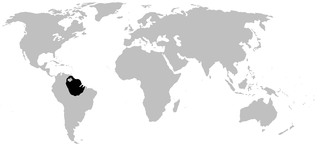
The Tukeit Hill frogs are three species of frog in the genus Allophryne. Originally erected for the species Allophryne ruthveni, the genus was placed as the only member of the subfamily Allophryninae, which was in turn placed in the family Centrolenidae, but they are now considered as the only genus in the monotypic family Allophrynidae.
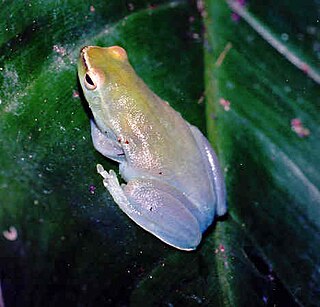
Sphaenorhynchus is a genus of frogs in the family Hylidae. They are also known as lime treefrogs or hatchet-faced treefrogs. They are found in the Amazon and Orinoco River basins of South America, the Guianas, Trinidad, and southern and eastern Brazil. The majority of the species are associated with the Atlantic Forest domain in Brazil.

Spikethumb frogs are a genus (Plectrohyla) of frogs in the family Hylidae found in Central America from southern Mexico through Guatemala and northern El Salvador to central and northern Honduras. A major revision of the Hylidae moved an additional 21 species to this genus from the genus Hyla. The additional species moved to Plectrohyla were identified as the Hyla bistincta group, also called the Plectrohyla bistincta group; a separate group from the initial Plectrohyla guatemalensis group. This phylogenetic classification was later revised by moving the Plectrohyla bistincta group from the genus Plectrohyla into a new genus called Sarcohyla. Meanwhile, the guatemalensis group remained in Plectrohyla. They are called spikethumb because of the spike on their thumbs, which is called a prepollex. The genus name comes from the Greek word plēktron ("spur") and hyla.
Myersiohyla is a genus of frogs in the family Hylidae. It was erected in 2005 following a major revision of the Hylidae and initially included four species that were previously placed in the genus Hyla. The genus is found in the tepui region of Guyana and Venezuela.

Charadrahyla is a genus of frogs in the family Hylidae. It is endemic to tropical southern Mexico. The generic name was derived from Greek charadra ("ravine") and Hyla, in reference to the habits of these frogs. Accordingly, common name ravine treefrogs has been coined for the genus.
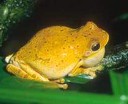
Tlalocohyla is a genus of frogs in the family Hylidae, also known as rain treefrogs or Middle American yellow-bellied treefrogs. They occur in Middle America between Mexico and Costa Rica. This genus was created in 2005 following a major revision of the Hylidae. The five species in this genus were previously placed in the genus Hyla.

Isthmohyla is a genus of frogs in the family Hylidae. This genus was erected in 2005 following a major revision of the Hylidae. The 15 species in this genus were previously placed in the genus Hyla. They are endemic to Central America in Honduras, Costa Rica, and Panama.

Ecnomiohyla, commonly known as fringe-limbed treefrogs or marvelous frogs, is a genus of frogs in the family Hylidae. This genus was erected in 2005 following a major revision of Hylidae. The ten original species in this genus were previously placed in the genus Hyla. The generic name Ecnomiohyla comes from Greek ecnomios and Hylas, the companion of Hercules.

Bokermannohyla is a genus of frogs in the family Hylidae. It was erected in 2005 following a major revision of the Hylidae. Twenty-three species previously placed in the genus Hyla were moved to this genus named in honor of Werner Carlos Augusto Bokermann, Brazilian herpetologist. The genus is endemic to southern Brazil.

Triprion spinosus, also known as the spiny-headed tree frog, spiny-headed treefrog, spinyhead treefrog, coronated treefrog, and crowned hyla, is a species of frog in the family Hylidae. It has a spotty distribution in Panama, Costa Rica, Honduras, and southern Mexico. Previously in its own monotypic genus Anotheca Smith, 1939, it was transferred to the genus Triprion in 2018.
Charadrahyla pinorum is a species of frog in the family Hylidae. It is endemic to the Pacific slopes of Sierra Madre del Sur between central Guerrero and southwestern and central Oaxaca, Mexico. Common names pine wood treefrog and Mexican pine woods treefrog have been proposed for it. Its closest relative is probably Charadrahyla juanitae.

Ingerophrynus is a genus of true toads with 12 species. The genus is found in southern Yunnan and Southeast Asia; from Myanmar and Indochina to peninsular Thailand and Malaya, Sumatra, Borneo, Java, Nias Island, Sulawesi, and the Philippines. This genus was established after a major taxonomical revision of frogs in 2006.
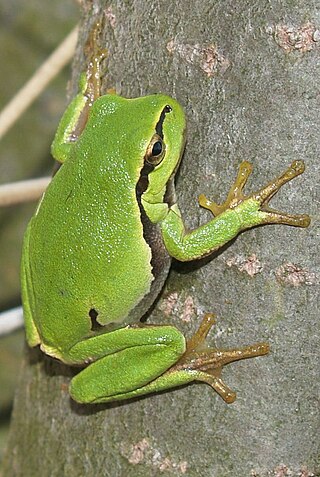
Hylinae is a large subfamily of "tree frogs", family Hylidae.
Jonathan Atwood Campbell is an American herpetologist. He is currently professor of biology at University of Texas at Arlington. He was a distinguished professor and chair of the Department of Biology, University of Texas at Arlington, Arlington, Texas.

Feihyla is a genus of frogs in the family Rhacophoridae, subfamily Rhacophorinae. They are found in southern China and Vietnam, and likely also in Laos. Its phylogenetic position is not yet fully resolved, but it is probably the sister taxon to Taruga, Polypedates, and Rhacophorus. Feihyla was originally erected to resolve polyphyly of Chirixalus by absorbing "Chirixalus palpebralis".

Atlantihyla is a genus of frogs in the family Hylidae. It is endemic to Central America, specifically to Honduras and Guatemala. The generic name refers to its distribution on the Atlantic side of the isthmus. The members of the genus are known as stream frogs.

Rheohyla is a genus of frogs in the family Hylidae. As currently recognized, it is monotypic, containing only Rheohyla miotympanum, also known as the small-eared hyla or small-eared treefrog. However, the nominal species likely is a complex of more than one species. It is endemic to eastern and central Mexico. The generic name refers to streams, the breeding habitat of this frog. The specific name is derived from Greek meion, a diminutive prefix, together with Greek tympanon (='drum') and refers to the small tympanum.
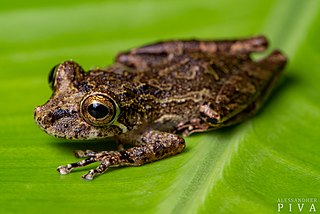
Ololygon is a genus of frogs in the family Hylidae. The majority of species in it are endemic to the Atlantic Forest of eastern Brazil, although the range of some species, including Ololygon aromothyella and Ololygon berthae, is known to extend south to northeastern Argentina, southern Paraguay, and Uruguay.
Bromeliohyla melacaena is a species of frogs in the family Hylidae. It is endemic to the Sierra de Omoa in northwest Honduras where it has been recorded from Cusuco National Park and Merendón Reserve.















